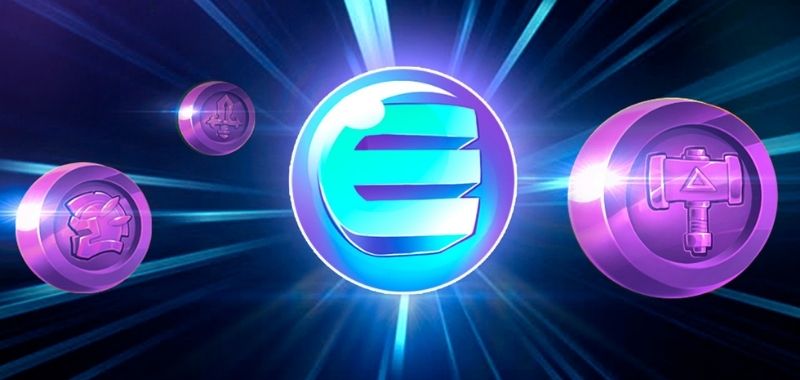Altcoins News
What is Polkadot?, introduction to the DOT token

Polkadot is a blockchain protocol designed to support multiple chains within a single network. His goal is to overcome a problem in today’s blockchain landscape: hundreds of blockchains exist in isolation and have little ability to communicate.
Polkadot history
Polkadot is developed by Parity Technologies, led by Gavin Wood and Jutta Steiner, two former Ethereum executives. The project is also supported by the Web3 Foundation, a closely related organization that provides the project with funding, advocacy, research, and collaborations.
Parity was founded in 2015. Initially, it started working on node software for Ethereum, called the Parity Ethereum client. The company has removed support for that project, leaving it to focus on Polkadot and a related project, Substrate.
Development started in November 2017, when the developers posted the first code on Github.
The company launched two proofs of concept in mid-2018 and implemented the first Polkadot parachain in July 2018. Polkadot was launched in an “initial” state in May 2020, and token transfers were enabled in August 2020.
As of September 2020, the Polkadot relay chain has not yet been activated and chain auctions are not yet active.
What is Polkadot?
As noted above, the Polkadot design is intended to support multiple chains. It is not simply a single blockchain that exists in isolation. There are several advantages to your approach:
- Scalability: Polkadot supports multiple blockchains through a mechanism called “chunking” or parachutes. This allows transactions to be processed efficiently and in parallel.
- Interoperability: Different Polkadot parachains and applications can share information and functionality thanks to the interoperable project design and cross-chain compatibility.
- Specialization: Each Polkadot parachain can be tailored to a specific use case or application.
- Forkless Upgrades: Polkadot can be upgraded without time-consuming and dividing hard forks; New features can be added without checking the entire network.
Substrate and Parachains
Each Polkadot chain is called a “Parachain”. Developers can create their own parachain with Substrate, a framework for building blockchains.
It is also possible to run blockchains developed with Substrate without being part of the Polkadot network; Polkadot simply provides interoperability, consensus, security, and other services for substrate-based chains.
Parachains can support functions found in many other blockchains, including smart contracts (Ethereum), ZK-snarks (Zcash), and UTXO transactions (Bitcoin). These characteristics are not a fundamental part of Polkadot; instead, these features can be added to and removed from parachutes.
Developers can also call functions that exist in other parachains.
There are many different use cases for Polkadot Parachutes, including Transaction Chains, Oracle Chains, Identity Chains, File Storage Chains, Data Preservation Chains, IoT Chains, Financial Chains, and Privacy Chains.
More than 25 projects are based on Polkadot, including Chainlink and Ocean Protocol. Here is a complete list of target projects.
Other Infrastructure

Parachains are just one of several components that make up the Polkadot network. Other components include:
- The Relay Chain: The main communication center between the parachutes and the DOT “backbone”.
- Parachains – Independent blockchains that run on top of the relay chain, linked together and reserved by auction.
- Parathreads: a lighter alternative to parachains for developers who just want to try Polkadot, offered under a “pay-as-you-go” model.
- Bridges – modules and contracts that connect to other blockchains such as Bitcoin and Ethereum .
Furthermore, there are several actors in the Polkadot network that keep the blockchain operational:
- The validators, who stake DOT tokens, validate the collectors’ tests and participate in the consensus.
- Nominators, who stake DOT tokens and secure the relay chain by selecting trusted validators.
- Classifiers, which collect transactions and create tests for validators.
- Fishermen, who monitor the network and report malicious activity.
The DOT token
Polkadot raised around $ 140 million by selling its DOT token in a 2017 ICO. The company also made two private sales in 2019 and 2020 and raised an estimated $ 100 million in those subsequent sales.
Due to a bug in Parity’s Ethereum wallet, about half of the original ICO tokens were frozen. Those frozen tokens have not been recovered, but the loss has not affected Polkadot’s ability to operate.
Polkadot began allowing investors to trade the remaining tokens starting in August 2020. Since then, DOT has been listed on more than 40 exchanges, and high trading volumes have caused the coin’s market capitalization to skyrocket and to become one of the top five cryptocurrencies.
The DOT token was also “redenominated” by a factor of 100x at the time trading began. This did not change the market capitalization of the token; it just made the token amounts more readable.

There are three main uses for the DOT token in addition to basic financial transactions: governance, participation, and linking.
Against the competition
There are at least two blockchains that can be considered competitors. Cosmos, which started operations in March 2020, aims to build a network of chains like Polkadot. However, there are technical differences between each platform.
If Polkadot is correct, his approach provides a more cooperative shared security model.
Ethereum 2.0 also has features that are comparable to those seen on Polkadot. Both blockchains are based on fragmentation or different chains dedicated to specific purposes. Again, there are some technical differences: Polkadot claims that his approach offers better availability and validity, and that it can work with fewer validators per chunk.
The project can also be compared to Tezos, which is also designed to support upgrades without hard forks; however, there are some other similarities between the two platforms.
Summary
Polkadot is a promising project. Since many application developers are looking for ways to reach a wider audience, and since there are many different blockchains, the platform could prove useful to many.
The high ranking position in the DOT token market can also be beneficial to the reputation of the project.
However, there are also some issues: Polkadot’s issues with token management, combined with the fact that there are more established platforms, could limit the scope of network adoption. Polkadot has yet to produce a “killer app” and it remains to be seen if it will enter the limelight beyond its initial price-related hype.
Altcoins News
Shiba Inu: Celebration for the Burning of 176 Million SHIB in a Historic Transaction

In an exciting development for the Shiba Inu community, September 20 marked a significant milestone as Shiba Inu’s official burn tracker announced that over 176 million SHIB tokens had been burned in a single transaction. But that’s not all; in the last 24 hours, a total of 135,933,606 SHIB tokens were burned, adding up to an impressive total of 521,814,163 tokens burned in just 7 days.
Impact on SHIB Price
As expected, this exceptional event has captured the attention of the cryptocurrency community and Shiba Inu investors worldwide. In the latest hourly update provided by Shibburn, the current price of the meme coin stands at $0.0000073, with a slight 0.15% decrease in the last hour. Although there has been a 1.34% decrease in the price in the last 24 hours, Shiba Inu’s market capitalization remains strong, valued at $4,297,527,749.
Lucie: The Voice of the Shiba Inu Community
On September 18, a key member of the Shiba Inu team, known as Lucie, addressed the community to answer burning questions about the highly anticipated SHIB token burn in Shibarium. Lucie emphasized that token burns are scheduled per transaction, meaning they occur based on the level of community participation. In a passionate plea, she urged SHIB holders to support this effort, stressing that SHIB burns are the result of close collaboration between developers and the community.
Lucie also pointed out that while it’s exciting to see enthusiasm for token burns, it’s crucial for the community to understand that SHIB burns are a community-driven initiative and not a call for developers to take immediate action.
Shibarium’s Focus: Strengthening BONE ShibaSwap
Amidst this backdrop of token burns, the Shibarium team has shifted its focus to strengthen the Bone ShibaSwap token, also known as BONE. Lucie emphasized that the implementation of BONE aims primarily to safeguard the interests of investors. To achieve this goal, the team has implemented a temporary locking contract along with a decentralized multi-signature wallet, ensuring maximum protection for Shiba Inu investors.
Shibarium’s Success with NOWNodes
Recently, Shibarium achieved an impressive feat by processing over 7 million RPC requests for the network in just one week. This achievement sets a new record for the platform and underscores the growing importance of Shibarium in the cryptocurrency ecosystem. NOWNodes, a node service provider supporting more than 80 blockchain networks, reported on this noteworthy accomplishment, highlighting Shibarium’s increasing relevance in the world of cryptocurrencies.
The Shiba Inu community is excited about these recent developments and the massive SHIB token burn, further bolstering their confidence in the project. With Shibarium gaining momentum and active community engagement, the future of Shiba Inu appears bright in the world of cryptocurrencies.
Altcoins News
Crypto Enforcement Funds Under Scrutiny: Congressman Emmer Calls For Restrictions On SEC

In a recent statement, Congressman Tom Emmer, a prominent figure in the GOP and a staunch advocate for crypto, expressed his concerns regarding the actions of Securities and Exchange Commission (SEC) Chair Gary Gensler.
Emmer accused Gensler of abusing his authority, leading to the expansion of the Administrative State while “disregarding the interests of the American people”.
To address these concerns, Emmer plans to sponsor an appropriations amendment aimed at restricting the SEC’s use of funds for crypto enforcement until clear rules and regulations are established.
Emmer Advocates For Clear Rules In The Crypto Industry
Emmer’s criticism of Chair Gensler centers on what he perceives as the weaponization of taxpayer dollars. Emmer argues that Gensler has utilized his position to further centralize regulatory control without ensuring a transparent and regulatory-friendly environment for the crypto industry.
By proposing to restrict the SEC’s funds for digital asset enforcement, Emmer seeks to emphasize the need for clear guidelines that protect both investors and innovators in the crypto space.
Addressing Senator Elizabeth Warren’s stance on cryptocurrencies, Emmer refers to her as a “control-freak senator” with an inclination towards centralized control.
He suggests that Warren favors a government-owned banking system and desires to retain the centralized power that comes with central banking. Emmer acknowledges the importance of central banking’s role but emphasizes the need for its evolution to adapt to the 21st century.
Emmer further asserts that attempts to suppress digital assets and cryptocurrencies are futile. He cites China’s unsuccessful ban on mining activities as evidence that even authoritarian regimes struggle to control decentralized technologies.
Emmer believes that a country like the United States, which “cherishes freedom”, cannot impede the progress of digital assets and cryptocurrencies.
The congressman’s remarks shed light on his perspective as an advocate for the crypto industry and his concerns regarding regulatory overreach. Emmer emphasizes the necessity of clear and balanced regulations that foster innovation while protecting investors.
By sponsoring an appropriations amendment, he aims to use the legislative process to ensure that the SEC’s enforcement actions align with well-defined rules and regulations.
As Emmer’s proposed amendment gains attention, it reflects the ongoing debate surrounding crypto regulations in the United States. The crypto industry seeks regulatory clarity to foster growth and innovation, while regulatory bodies like the SEC aim to protect investors and maintain market integrity.
Finding the right balance between oversight and innovation remains a key challenge, and Emmer’s efforts contribute to shaping the future of crypto regulation in the United States.
It remains to be seen how Emmer’s appropriations amendment will progress through the legislative process and how it will be received by his colleagues.
As the nascent industry continues to evolve, the role of Congress and regulatory agencies in establishing a clear and balanced regulatory framework will be crucial for its long-term success and widespread adoption.
Featured image from iStock, chart from TradingView.com
Altcoins News
US Forces Young Hacker To Forfeit $5.2 Million In Bitcoin

Last month, Ahmad Wagaafe Hared, a young hacker based in the United States, was ordered to forfeit approximately $5.2 million worth of Bitcoin (BTC), Stellar (XLM), and a BMW sports car to the government. According to a report, this order was made last week due to Hared’s involvement in a SIM-swapping scheme that targeted crypto executives in North California and the Bay Area.
The Bitcoin SIM-Swapping Hack
The SIM-swapping scheme, orchestrated by Hared–who went by the alias “winblo” — began in 2016 and was stopped by local authorities in 2019.
Hared and his accomplices obtained their victims’ contact information before entering a plea agreement with law enforcement agencies. They would then contact cellphone service providers, manipulating company representatives into believing they were the legitimate owners of the targeted phone numbers.
After that, they swapped cards, illegally taking control of their victims’ phone numbers. With this scheme, the hacker gained unauthorized access to their victims’ email and other crypto accounts before transferring coins.
The success of this scheme is evident in the significant amount of assets ordered for forfeiture. Hared must surrender 119.8 BTC, valued at $5.2 million, and 93,420 XLM, worth $11,770. A 2017 BMW sports car, believed to be proceeds of crime, must also be surrendered to the state.
The young hacker has been under arrest for over three years now. As mentioned, in 2019, Hared entered a plea agreement, though many case documents remain sealed, and the deal has not been disclosed to the public. Hared will be sentenced in January 2024 after pleading guilty to conspiracy to commit wire fraud.
According to details, this case is tied to another SIM-swapping scheme, which saw the indictment of Anthony Francis Faulk, also known as “shade,” who pleaded guilty to conspiracy to commit wire fraud in 2019.
Hackers Have Stolen Over $200 Million In 2023 Alone
In a recent report, blockchain intelligence firm Chainalysis claimed that hackers linked to North Korea have stolen over $200 million worth of cryptocurrencies to finance their nuclear weapons program.
In August, Lazarus Group said to be sponsored by the North Korean regime, was linked to the $34 million CoinsPaid hack. They were also reportedly behind the Stake.com hack, the FBI claims. The hit on the crypto casino saw over $40 million of coins robbed.
As part of their activities, hackers employ several tactics to steal Bitcoin and coins, including SIM-swapping, phishing, supply chain attacks, and infrastructure hacks.
Feature image from Canva, chart from TradingView
-
Opinion2 years ago
XRP: FOX Business Senior Correspondent Says SEC Is Losing Its Lawsuit Against Ripple
-
Tutorials3 years ago
How to Earn, Farm and Stake CAKE on PancakeSwap with Trust Wallet
-
Altcoins News3 years ago
Projects with ongoing migration from Ethereum to Cardano
-
NFT3 years ago
CardanoKidz: The first NFTs arrive at Cardano
-
Tutorials3 years ago
How to set up a Bitcoin node: beginner’s guide
-
NFT3 years ago
SpaceBudz: new astronaut NFTs on Cardano
-
DeFi News3 years ago
Uniswap vs PancakeSwap: Full analysis
-
DeFi News3 years ago
Liqwid Finance the first DeFi project on Cardano: everything you need to know


















